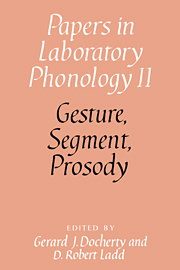Book contents
- Frontmatter
- Contents
- List of contributors
- Acknowledgments
- Introduction
- Section A Gesture
- 1 An introduction to task dynamics
- 2 “Targetless” schwa: an articulatory analysis
- 3 Prosodic structure and tempo in a sonority model of articulatory dynamics
- 4 Lenition of |h| and glottal stop
- 5 On types of coarticulation
- Section B Segment
- Section C Prosody
- Appendix 1 The test phrases (bold type) of experiment 1 in the context in which they were read
- Appendix 2 The distractors (bold type) of experiment 1 in the context in which they were read
- Appendix 3 The test sentences of experiment 2. The test words are in bold type
- Appendix 4 The distractor sentences of experiment 2. The distractors are in bold type
- References
- Name index
- Subject index
3 - Prosodic structure and tempo in a sonority model of articulatory dynamics
from Section A - Gesture
Published online by Cambridge University Press: 18 December 2009
- Frontmatter
- Contents
- List of contributors
- Acknowledgments
- Introduction
- Section A Gesture
- 1 An introduction to task dynamics
- 2 “Targetless” schwa: an articulatory analysis
- 3 Prosodic structure and tempo in a sonority model of articulatory dynamics
- 4 Lenition of |h| and glottal stop
- 5 On types of coarticulation
- Section B Segment
- Section C Prosody
- Appendix 1 The test phrases (bold type) of experiment 1 in the context in which they were read
- Appendix 2 The distractors (bold type) of experiment 1 in the context in which they were read
- Appendix 3 The test sentences of experiment 2. The test words are in bold type
- Appendix 4 The distractor sentences of experiment 2. The distractors are in bold type
- References
- Name index
- Subject index
Summary
Introduction
One of the most difficult facts about speech to model is that it unfolds in time. The phonological structure of an utterance can be represented in terms of a timeless organization of categorical properties and entities – phonemes in sequence, syllables grouped into stress feet, and the like. But a phonetic representation must account for the realization of such structures as physical events. It must be able to describe, and ultimately to predict, the time course of the articulators moving and the spectrum changing.
Early studies in acoustic phonetics demonstrated a plethora of influences on speech timing, with seemingly complex interactions (e.g. Klatt 1976). The measured acoustic durations of segments were shown to differ widely under variation in overall tempo, in the specification of adjacent segments, in stress placement or accentuation, in position relative to phrase boundaries, and so on. Moreover, the articulatory kinematics implicated in any one linguistic specification – tempo or stress, say – showed a complicated variation across speakers and conditions (e.g. Gay 1981). The application of a general model of limb movement (task dynamics) shows promise of resolving this variation by relating the durational correlates of tempo and stress to the control of dynamic parameters such as gestural stiffness and amplitude (e.g. Kelso et al. 1985; Ostry and Munhall 1985). However, the mapping between these parameters and the underlying phonological specification of prosodic structure is not yet understood.
- Type
- Chapter
- Information
- Gesture, Segment, Prosody , pp. 68 - 89Publisher: Cambridge University PressPrint publication year: 1992
- 46
- Cited by



